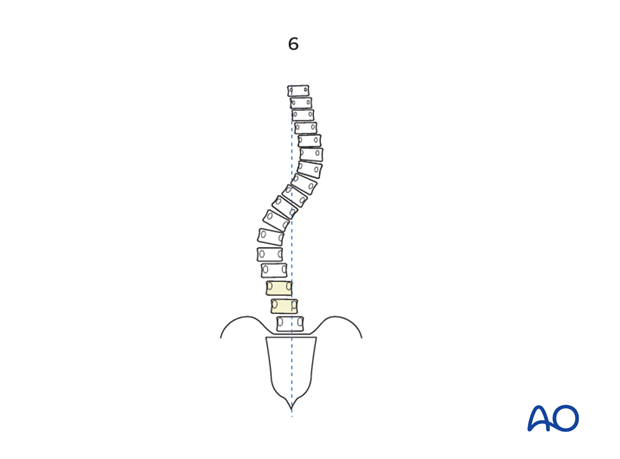Selection of fusion level
1. General
There are no strict guidelines for fusion level selection in AIS patients. The following is the recommendation of the authors.
2. Curve type 1
The recommended treatment for type 1 curves is the fusion of the structural main thoracic curve. The upper instrumented vertebra (UIV) is typically T3 – T5 while the lowest instrumented vertebra (LIV) will vary considerably based on the location of the stable and the neutral vertebrae.
UIV
The selection of the UIV is dependent upon shoulder balance or the presence of proximal thoracic kyphosis. An effort is made not to end the construct at a region of kyphosis.
For a given right main thoracic curve with level shoulders, T3 would be the UIV of choice while T4 or T5 would be selected if the right shoulder was higher.
Although rare in type 1 curves, T2 may be selected as a UIV if the left shoulder is higher than the right.
Generally speaking UIV selection may be dynamic based on the amount of MT correction planned intraoperatively. The more correction planned the more the tendency to fuse higher into the PT region to avoid elevation of the contralateral shoulder. (ie. Left shoulder elevation when treating a right MT curve.
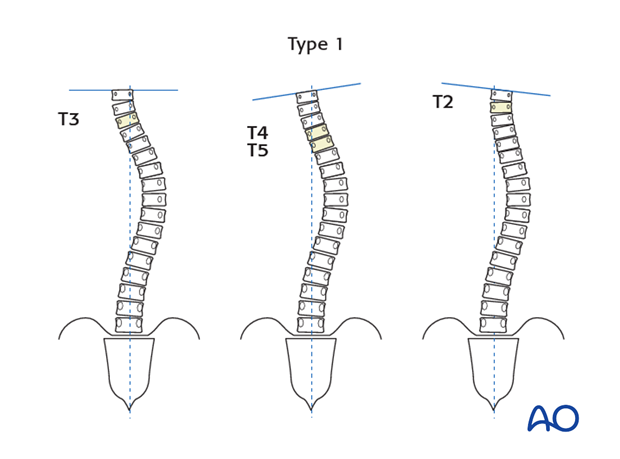
LIV
The selection of the LIV is dependent on the lumbar modifier and the CSVL.
For lumbar modifier A and B, the LIV can be selected as the most cephalad lumbar vertebra that is intersected by the CSVL and neutral in rotation.
The LIV will usually fall between the end vertebra of the main thoracic curve and the stable vertebra.
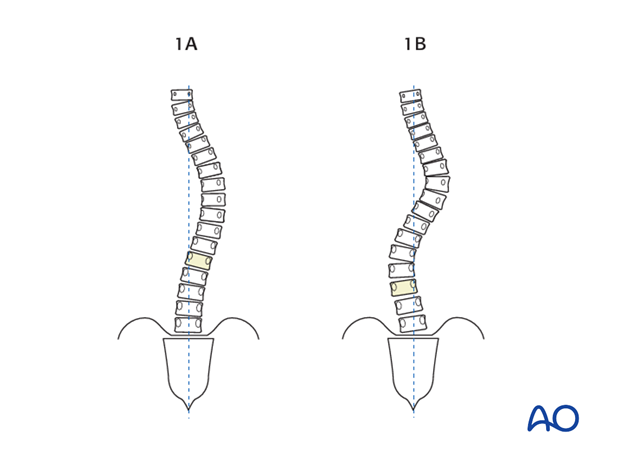
Lumbar modifier C curves are eligible for selective thoracic fusions. When performing a selective thoracic fusion it is important to maintain some coronal tilt of the LIV in order to maintain coronal balance. Typically the LIV in this situation will be the stable vertebra (either T11, T12 or L1).
Selective thoracic fusions should be performed after careful consideration of curve magnitudes apical vertebral rotation and translation, sagittal profile and clinical deformity assessment (angle of truncal rotation, waist line asymmetry, shoulder balance, skeletal maturity).
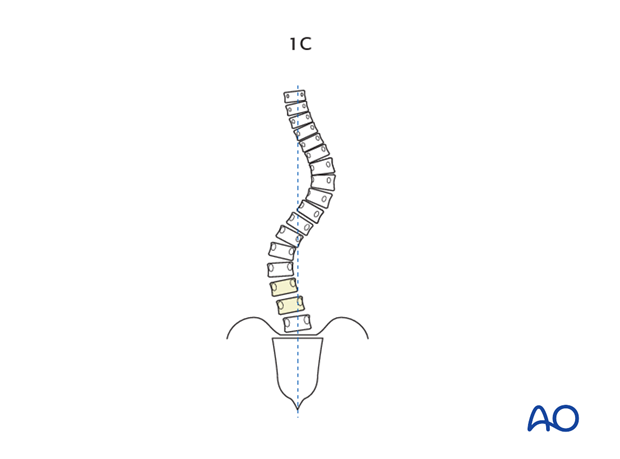
3. Curve type 2
The recommended treatment for type 2 curves is fusion of the proximal thoracic and main thoracic curve.
UIV
The selection of the UIV is dependent upon shoulder balance or the presence of proximal thoracic kyphosis. An effort is made not to end the construct at a region of kyphosis.
For a given right main thoracic curve with level shoulders, T2 or T3 would be the UIV of choice while T3 or T4 would be selected in the rare circumstance when the right shoulder was higher.
T2 would be selected as the UIV of choice if the left shoulder is higher than the right. Generally speaking, a more cephalad UIV will allow for better control of proximal deformity and shoulder balance.
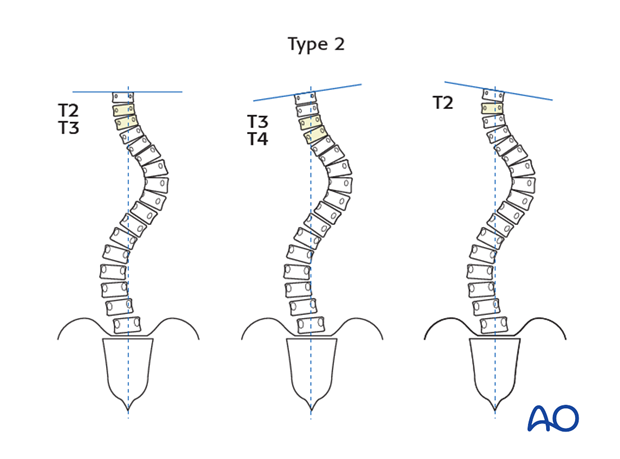
LIV
The selection of the LIV is dependent on the lumbar modifier and the CSVL. For lumbar modifier A and B, the LIV can be selected as the most cephalad lumbar vertebra that is intersected by the CSVL and neutral in rotation.
The LIV will usually fall between the end vertebra of the main thoracic curve and the stable vertebra.

Lumbar modifier C curves are eligible for selective thoracic fusions. When performing a selective thoracic fusion it is important to maintain some coronal tilt of the LIV in order to maintain coronal balance. Typically the LIV in this situation will be the stable vertebra (either T11, T12 or L1).
Selective thoracic fusions should be performed after careful consideration of curve magnitudes apical vertebral rotation and translation, sagittal profile and clinical deformity assessment (angle of truncal rotation, waist line asymmetry, shoulder balance, skeletal maturity).

4. Curve type 3
The recommended treatment of type 3 curves is the fusion of both the major main thoracic and structural thoracolumbar/lumbar curve.
UIV
The selection of the UIV is dependent upon shoulder balance or the presence of proximal thoracic kyphosis. An effort is made not to end the construct at a region of kyphosis.
For a given right main thoracic curve with level shoulders, T3 would be the UIV of choice while T4 or T5 would be selected if the right shoulder was higher.
Although rare in type 1 curves, T2 may be selected as a UIV if the left shoulder is higher than the right.
Generally speaking UIV selection may be dynamic based on the amount of MT correction planned intraoperatively. The more correction planned the more the tendency to fuse higher into the PT region to avoid elevation of the contralateral shoulder. (ie. Left shoulder elevation when treating a right MT curve).
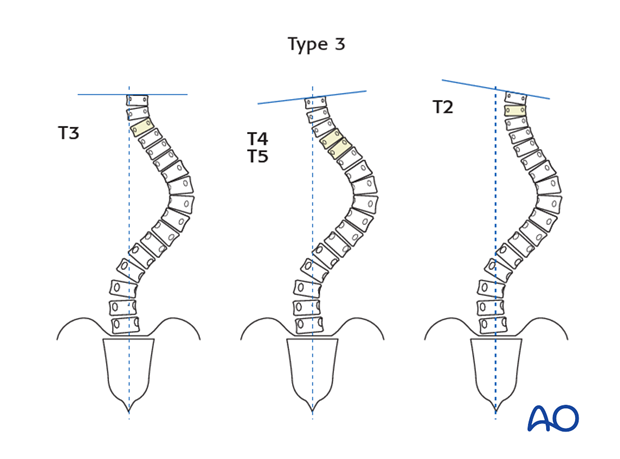
LIV
The LIV will typically be between L3 and L4. The decision to select L3 vs. L4 as the LIV is dependent upon bending X-rays, apical translation and rotation. Generally speaking, one can stop at L3 when:
- The L3-L4 disc is parallel or closed on the convexity
- L3 is neutral or no more than grade 1 rotation
- On opposite side bending L3 centers and horizontalize on the sacrum
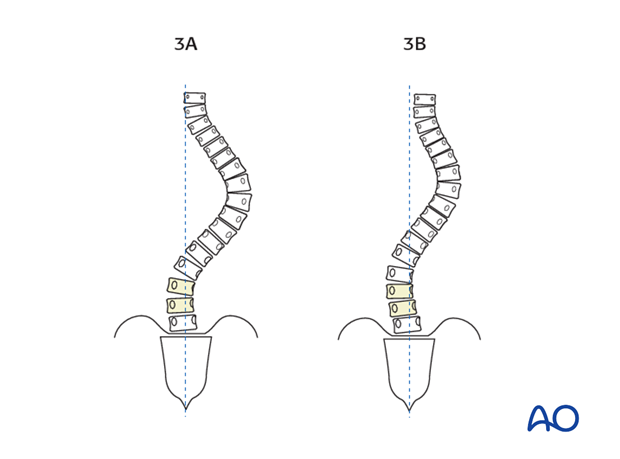
In highly select cases, lumbar modifier C curves are eligible for selective thoracic fusions. This occurs when the ratio of thoracic to lumbar radiographic and clinical parameters are much greater in the thoracic than in the lumbar region.
When performing a selective thoracic fusion it is important to maintain some coronal tilt of the LIV in order to maintain coronal balance. Typically the LIV in this situation will be the stable vertebra (either T11, T12 or L1).
Selective thoracic fusions should be performed after careful consideration of curve magnitudes apical vertebral rotation and translation, sagittal profile and clinical deformity assessment (angle of truncal rotation, waist line asymmetry, shoulder balance, skeletal maturity).
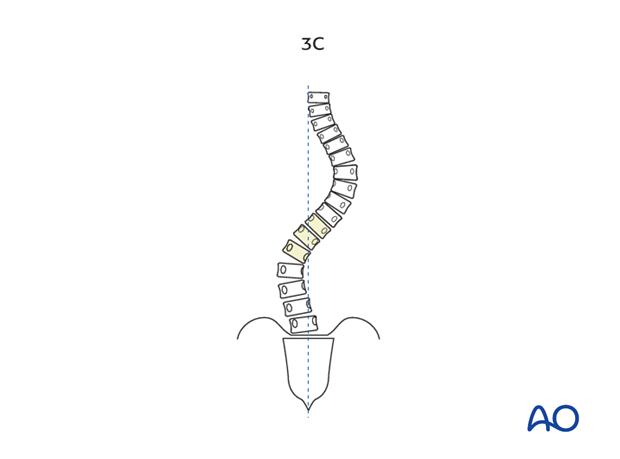
5. Curve type 4
UIV
The selection of the UIV is dependent upon shoulder balance or the presence of proximal thoracic kyphosis. An effort is made not to end the construct at a region of kyphosis.
For a given right main thoracic curve with level shoulders, T2 or T3 would be the UIV of choice while T3 or T4 would be selected in the rare circumstance when the right shoulder was higher.
T2 would be selected as the UIV of choice if the left shoulder is higher than the right. Generally speaking, a more cephalad UIV will allow for better control of proximal deformity and shoulder balance.
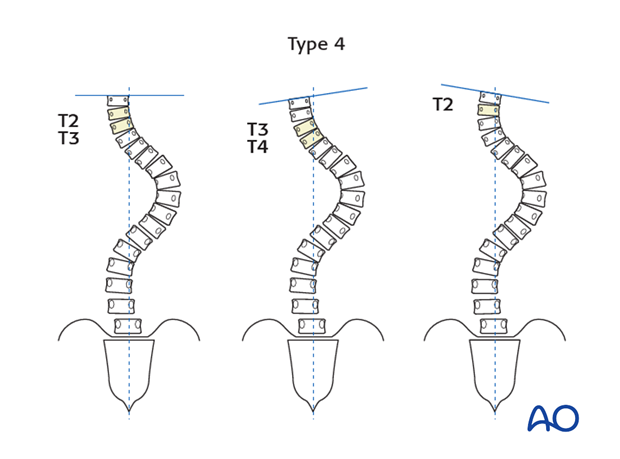
LIV
The LIV will typically be between L3 and L4. The decision to select L3 vs. L4 as the LIV is dependent upon bending X-rays, apical translation and rotation.
Generally speaking, one can stop at L3 when:
- The L3-L4 disc is parallel or closed on the convexity
- L3 is neutral or no more than grade 1 rotation
- On opposite side bending, L3 centers and horizontalize on the sacrum.
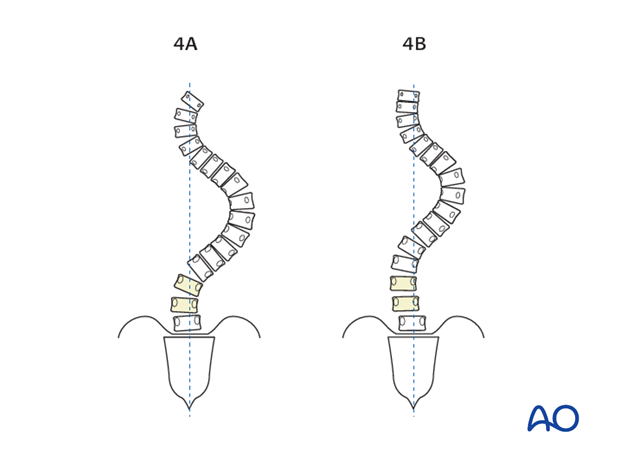
In highly select cases, lumbar modifier C curves are eligible for selective thoracic fusions. This occurs when the ratio of thoracic to lumbar radiographic and clinical parameters are much greater in the thoracic than in the lumbar region. When performing a selective thoracic fusion it is important to maintain some coronal tilt of the LIV in order to maintain coronal balance. Typically the LIV in this situation will be the stable vertebra (either T11, T12 or L1).
Selective double thoracic fusions should be performed after careful consideration of curve magnitudes apical vertebral rotation and translation, sagittal profile and clinical deformity assessment (angle of truncal rotation, waist line asymmetry, shoulder balance, skeletal maturity).
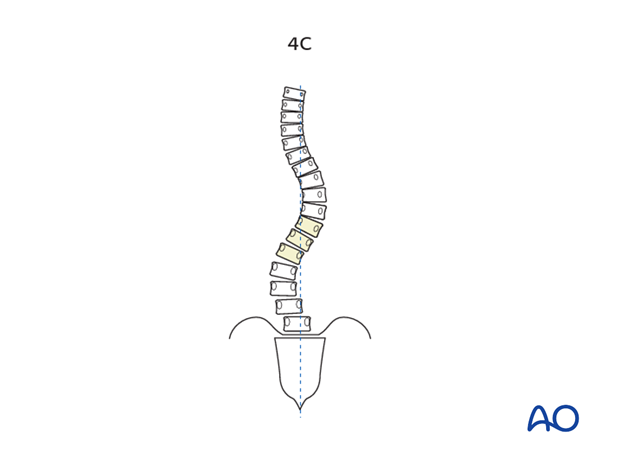
6. Curve type 5
The recommended treatment for type 5 curves is fusion of the entire thoracolumbar/lumbar curve (generally end vertebra to end vertebra). The goal is to horizontalize the LIV and tailor the amount of residual tilt in the UIV based on the magnitude of the thoracic curve in order to optimize shoulder balance.
A common scenario is when there are potentially two lower end vertebra with the disk parallel between them. When this occurs at L3 and L4, generally speaking one can stop at L3 when:
- The L3-L4 disc is parallel or closed on the convexity
- L3 is neutral or no more than grade 1 rotation
- On opposite side bending, L3 centers and horizontalize on the sacrum.
Occasionally the thoracic curve, although non-structural may necessitate inclusion in the fusion dependent on the amount of clinical deformity (rib prominence), shoulder imbalance and junctional kyphosis.
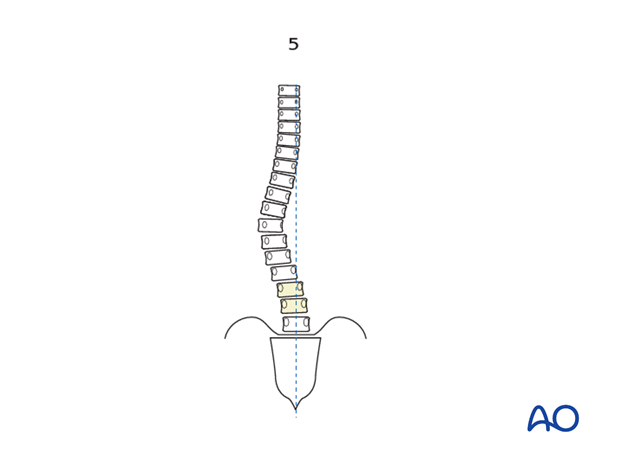
7. Curve type 6
In type 6 curves, typically both the main thoracic and the thoracolumbar/lumbar curve are fused. These curves are treated very similarly to type 3 curves.
UIV
The selection of the UIV is dependent upon shoulder balance or the presence of proximal thoracic kyphosis. An effort is made not to end the construct at a region of kyphosis.
For a given right main thoracic curve with level shoulders, T3 would be the UIV of choice while T4 or T5 would be selected if the right shoulder was higher.
Although rare in type 1 curves, T2 may be selected as a UIV if the left shoulder is higher than the right.
Generally speaking UIV selection may be dynamic based on the amount of MT correction planned intraoperatively. The more correction planned the more the tendency to fuse higher into the PT region to avoid elevation of the contralateral shoulder. (ie. Left shoulder elevation when treating a right MT curve.
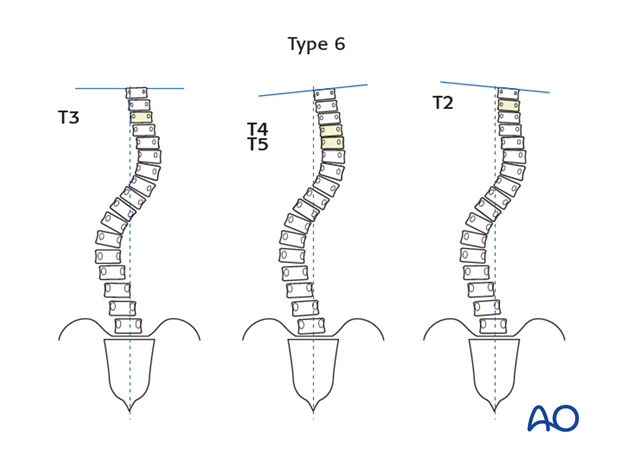
LIV
The LIV will typically be between L3 and L4. The decision to select L3 vs. L4 as the LIV is dependent upon bending X-rays, apical translation and rotation.
Generally speaking, one can stop at L3 when:
- The L3-L4 disc is parallel or closed on the convexity;
- L3 is neutral or no more than grade 1 rotation
- On opposite side bending, L3 centers and horizontalize on the sacrum
In highly select cases lumbar fusions can be performed after careful consideration of curve magnitudes apical vertebral rotation and translation, sagittal profile and clinical deformity assessment (angle of truncal rotation, waist line asymmetry, shoulder balance, skeletal maturity). To balance the spine this will typically mean partial correction of the lumbar curve to accommodate residual thoracic curvature.
